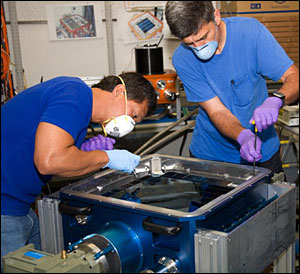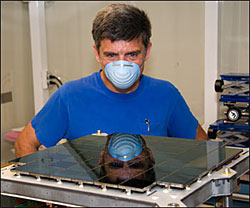
Camera Scans Sky for Killers
MAUI, Hawaii, Sept. 4, 2007 -- A gigapixel camera that can see stars millions of times fainter than are visible to the naked eye has been installed on the Pan-STARRS-1 (PS1) telescope on Halekala, Maui, to scan the skies for "killer" asteroids and other objects that might pose a danger to Earth.
The advanced digital camera -- the largest in the world -- was built at the University of Hawaii at Manoa's Institute for Astronomy (IfA) in Honolulu. The full observatory will consist of four 1.8-meter diameter optical systems that will be aimed at the same point in the sky, and each telescope will be equipped with its own gigapixel camera.
Pan-STARRS' primary purpose is to discover and characterize Earth-approaching objects, both asteroids and comets, that might pose a danger to the planet, but astronomers are also expecting its wide-field imaging capability to be used to create the most comprehensive catalog of the stars and galaxies available to date. 
Institute for Astronomy electronics engineer Peter Onaka (left) and astronomer John Tonry assemble the Pan-STARRS gigapixel camera. (Photos by Richard Wainscoat)
"This is a truly giant instrument," said astronomer John Tonry, who led the team that developed the new camera. "It allows us to measure the brightness of the sky in 1.4 billion places simultaneously. We get an image that is 38,000 by 38,000 pixels in size, or about 200 times larger than you get in a high-end consumer digital camera. It's also extremely sensitive; in a typical observation we will be able to detect stars that are 10 million times fainter than can be seen with the naked human eye."
The camera is a key component of the Pan-STARRS (Panoramic Survey Telescope and Rapid Response System) project, which is designed to search the sky for objects that move or vary. When fully operational, each patch of sky visible from Hawaii will be photographed automatically at least once a week. Powerful computers at the Maui High Performance Computer Center will scrutinize each image for the minuscule changes that could signal a previously undiscovered asteroid. Other computers will combine the data from several images, calculate the orbit of the asteroid, and send warning messages if the asteroid has any chance of colliding with Earth during the next century.

The Pan-STARRS gigapixel camera.
The silicon chips at the heart of the camera were developed in collaboration with Lincoln Laboratory of the Massachusetts Institute of Technology. They contain advanced circuitry that makes instantaneous corrections for any image shake caused by Earth's turbulent atmosphere. The image area, which is about 16 inches (40 cm) across, contains 60 identical silicon chips, each of which contains 64 independent imaging circuits.
Splitting the image area into about 4000 separate regions in this way has three advantages, according to the scientists: Data can be recorded more quickly, "dazzling" of the image by a very bright star is confined to a small region, and any defects in the chips only affect only a small part of the image area.

John Tonry inspects the Pan-STARRS gigapixel camera.
So much data will be produced by the camera that the team in Manoa has had to develop novel ways to handle the deluge. Electronics engineer Peter Onaka led the team that designed an ultrafast 480-channel control system, while a group led by astronomer Eugene Magnier developed the software that is able to analyze the thousands of gigabytes of data that the camera will produce each night.
"This camera is an incredibly complex instrument, and getting it working has been a magnificent achievement by IfA scientists and engineers. The Pan-STARRS project will revolutionize many areas of astronomy," said IfA Director Rolf-Peter Kudritzki.
For more information, visit: www.ifa.hawaii.edu
Published: September 2007